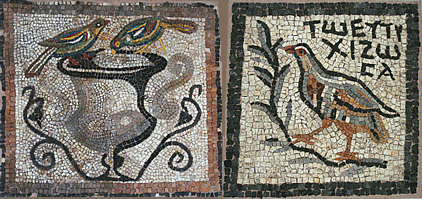

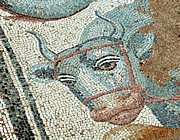
On the Aegean coast and the pleasant town of Platamonas, through the countryside with views of Greece's highest mountain, the mythic home of the gods, and the amazingly well-preserved atmospheric ancient city of Dion.
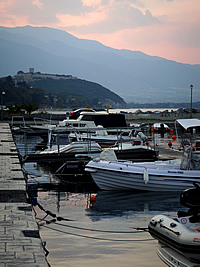
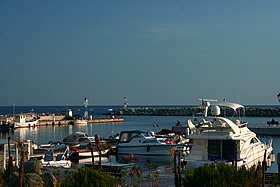
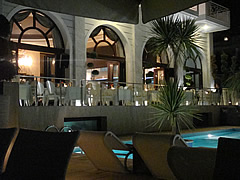
After visiting Meteora we drove through parched landscape, and the rather more interesting gorge of the Vale of Temba, to Platamonas on the east coast. We stayed in the Hotel Royal Palace; lovely hotel and location right on the little harbour, but the service could have been a bit more attentive. We had a room on the harbour side of the hotel with views out to sea; lovely in the early morning to watch the flotilla of small boats heading out to the fishing grounds.
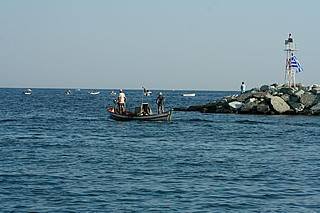
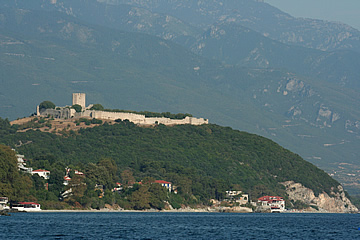
On the northern edge of the town the castle of Platamonas commands an impressive position, on a hill close to the sea and with extensive views inland. Its situation at the head of the Vale of Temba guards the ancient route between Macedonia and Thessaly.
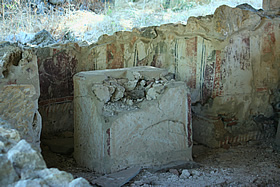
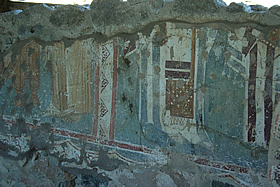
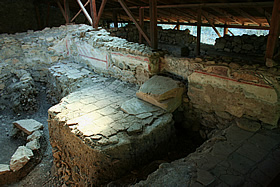
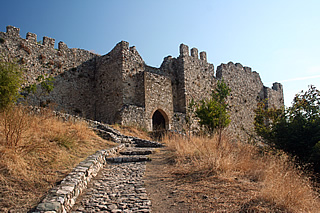
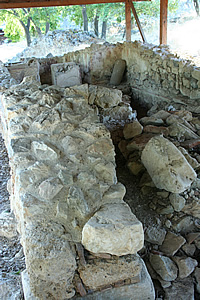
This Crusader castle dates from 1204 and was built on the ruins of an earlier Byzantine 10th century castle, itself built on the site of a 4th century BC Hellenistic fortification. The castle consisted of three baileys or fortified enclosures and a keep with encircling walls, the outer wall reinforced with eight towers. Additionally there were officers quarters and early churches, all but one of which were destroyed by the Turks who took the castle at the end of the fourteenth century, converting the remaining church into a mosque.
In the ruins of two churches are a few poor fragments of the frescoes which once decorated the walls.
The entrance to the hexagonal keep is high in the wall and, according to the Green Guide, could only be reached with ladders.
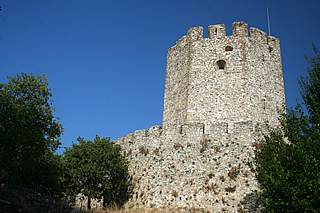
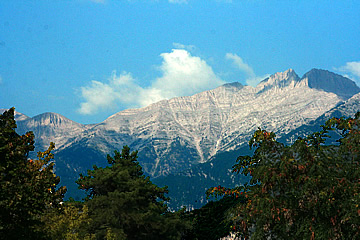
The highest mountain in Greece at 2,918 metres (9,573 ft) and legendary home of the twelve Greek gods. North west of Platamonas and 20km from the sea, the area within which it lies became the first Greek National Park in 1938, extending for 238 square kilometres around the mountain.
The mountain itself encompasses several peaks including Mytikas, the highest, known as Pantheon in ancient times when it was believed to be the meeting place of the gods. The ravines on the mountainside were said to be where the gods lived.
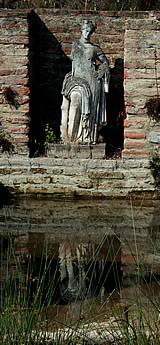
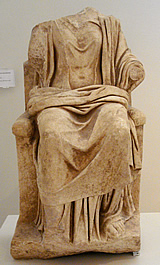
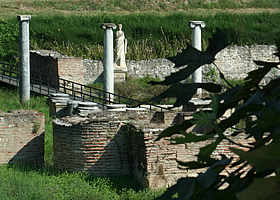
One of the most atmospheric archaeological sites we have visited. It requires a good few hours to see properly as so much of the town and outlying sanctuaries has been excavated. We were the only people wandering around in the morning, when we explored the sanctuary area. Almost a magical feel of the past, especially at the Sanctuary of Isis.
Dedicated to Zeus (Dias - of Zeus) this ancient settlement was given a huge boost in the 5th century BC by King Archelaos I, the same king who made Pella the capital of Macedonia. Here he instituted a festival of athletics and drama in honour of Zeus. The Macedonian kings made sacrifices to the gods in Dion before going into battle and celebrated their victories here on their return - Alexander the Great made sacrifices here before setting off on his eastern journeys.
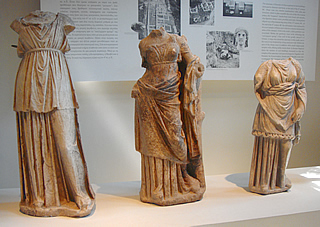
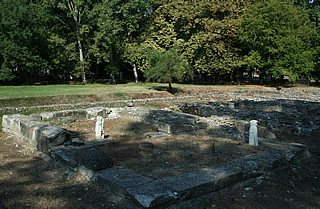
Apart from the large temple to Zeus there were several other sanctuaries including one for the earth goddess Demeter and another for the Egyptian goddess Isis - a favourite of Alexander. Building work stretched from the time of the founding of the city through the Hellenistic period up until Roman times - a Roman colony was founded here by Augustus around 30BC. In the 5th century AD a series of earthquakes caused evacuation of the town which was subsequently engulfed in mud.
Many statues and artefacts have been found at the site, such as a cult statue of Hera, wife and one of the three sisters of Zeus, which had later been built into an early Christian wall. The original artefacts have been removed to the excellent museum for safe keeping, but there are a good number of replicas in place. The site is divided between the sanctuary area and the site of the ancient city and there are lots of information boards. Much of the sanctuary area is waterlogged and the extensive city is very exposed, with little shade.
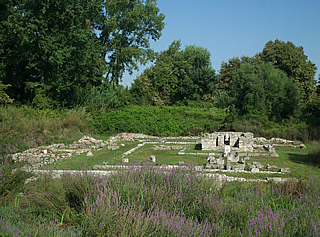
Traces of 6th century BC buildings have been found on the site of the Sanctuary of Demeter, the Greek goddess of harvests, earth fertility and the seasons. These were succeeded by Hellenistic buildings - two late 4th century BC Doric temples dedicated to Demeter and her daughter Persephone, with renovations in the Roman period. Originally there would have been a number of altars in front of the temples for sacrifices and libations. Now there are only low walls and a few replica statues.
Nearby, towards the River Vaphyras, is the Sanctuary of Zeus Hypsistos, a monotheistic cult. It consisted of a courtyard surrounded by colonnaded galleries and rooms.
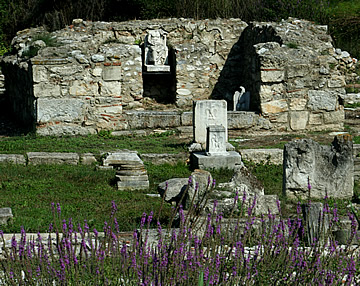
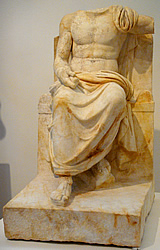
On the north side of the sacred precinct stood the small temple dedicated to Zeus Hypsistos, where a statue of the god, raised on a pedestal and holding his trademark thunderbolt in his right hand, was found. It was probably originally accompanied by the statue of Hera found built into the city wall.
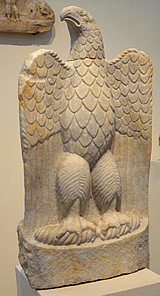
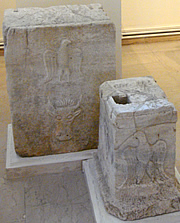
A large marble eagle stood to one side of the statue of Zeus. There was an altar, with a relief of an eagle and a bull, in front of the temple and a stone block, also with a carved relief of an eagle, set with an iron ring where animals would have been tied before sacrifice. The originals can all be seen in the museum.
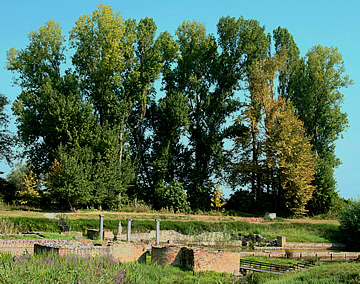
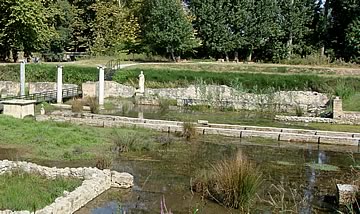
Just across the river is the tranquil Sanctuary of Isis. In ancient times there existed here a sanctuary dedicated to Artemis, the goddess of childbirth, and Aphrodite, the goddess of the foothills of Olympus. In the second century AD Artemis was succeeded by the Egyptian goddess Isis. The ruins of these older buildings have been found beneath the current second century AD buildings.
The sanctuary is composed of a sacred precinct and several temples, one dedicated to the cult of Aphrodite. Two of the smaller temples, dedicated to Isis Tyche and Aphrodite Hypolympidia, shelter sacred springs. The main temple was dedicated to Isis Lochia, the goddess protecting women following childbirth. The central court of the precinct was crossed by a long, straight pavement flanked by low walls, meant to represent the River Nile.
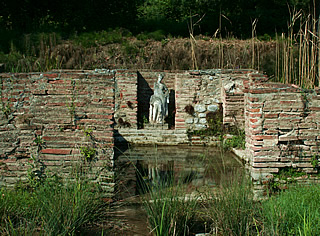
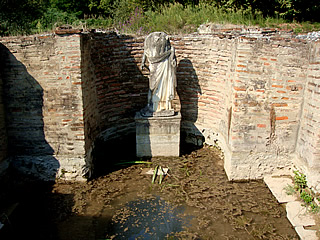
The site lies underwater, crossed by a raised walkway, but is peaceful and very atmospheric. Statues reflect in the still waters, broken only by the stealthy progress of a white egret.
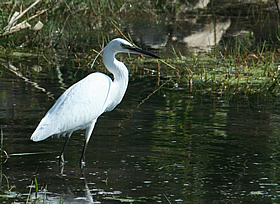
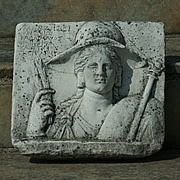 Isis as Demeter.
Isis as Demeter.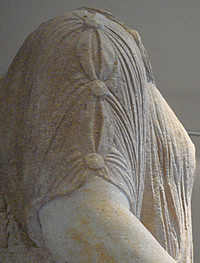
Among the ruins of the main temple a relief dedicated to the triad Sarapsis-Isis-Anubis was found. It was originally on the facade of the main temple and depicted the goddess as Demeter, holding a sheaf and a sceptre. On the marble steps intriguing slabs with the imprints of feet were discovered; they are said to have been left by pilgrims - amazing!
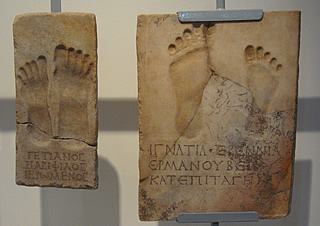
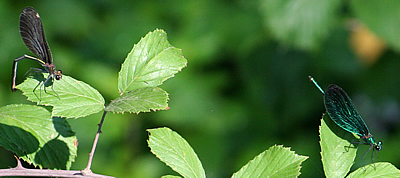

The wet landscape near the river was swarming with brightly coloured insects, I think they were damselflies, but absolutely beautiful - especially the male!
One of the photographs also turned out to have a praying mantis in it - though we didn't spot it at the time!
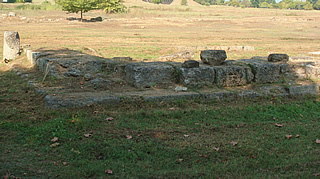
Of the Sanctuary of Olympian Zeus almost nothing remains. Once it would have been the most splendid and revered of sacred sanctuaries, where the Macedonian kings made their sacrifices and celebrated their victories with magnificent feasts. Here the New Year celebrations took place, at the end of September in the Macedonian calendar, when many animal sacrifices would have been made. Before embarking on his eastern campaigns, Alexander the Great sacrificed here at the great altar of Zeus Olympus. Traces of the 4th century BC altar, originally 22 metres long, remain. In front of it were three rows of eleven tethering blocks for the sacrificial animals. The sacrifice of a hundred oxen, known as a hecatomb, was an important element of the public cult of Zeus.
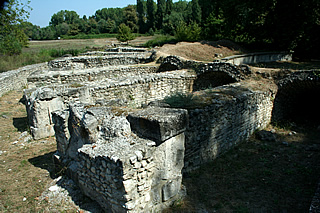
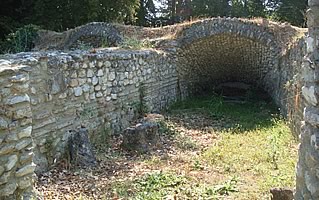
In 219 BC the sanctuary was burned to the ground by an Aetolian army but the citizens of Dion rebuilt it, burying in pits many of the destroyed dedications - pits which have now been uncovered revealing artefacts and historically important inscriptions.
Inside the sanctuary were statues of the Macedonian kings and probably the famous bronze horsemen commissioned by Alexander and created by Lysippos, representing 25 of Alexander's companions who, though Alexander was victorious, fell at the Battle of the Granikos River in 334BC. The bronzes were carried off to Rome by the Roman general Metellus in 148BC.
To the north are the remains of a small baths complex and nearby to the south - on top of part of the Sanctuary of Olympian Zeus - the small, horseshoe-shaped Roman theatre, probably built during the reign of the Emperor Hadrian in the second century AD. Wedge-shaped vaults supported 24 tiers of stone seats.
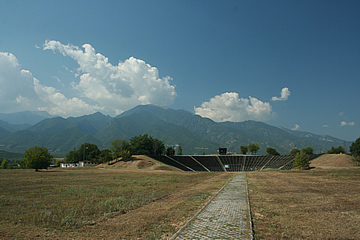
The much larger Hellenistic theatre, which today is covered with wooden seating, was built in the second half of the third century BC to replace an earlier construction. The later theatre was built into an artificial hill which supported the rows of seats.
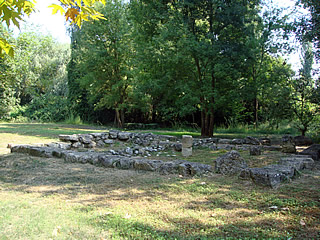
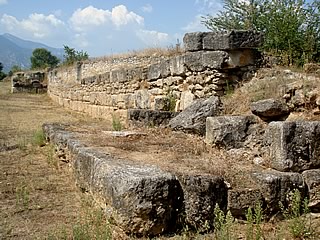
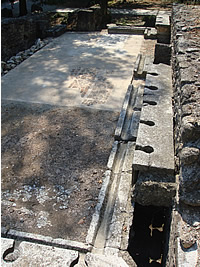

The Sanctuary of Asklepios is called an Asklepion, dedicated to the god of medecine and healing, revered throughout the civilised ancient Greek world, for instance at Pergamon. Asklepios is usually depicted with a staff around which a snake is entwined. This has continued through the millenia to be a symbol of the healing arts. A snake might seem an odd choice for such a symbol and the reasons for its use are disputed. A particular type of non-venomous snake was allowed into the Asklepion sanctuaries, it is known now as Aesculapian Snake.
The remains of the sanctuary are situated within a shady grove of trees, though the nearby presence of springs would have been important in its location as pure water was essential in the practices of the cult.
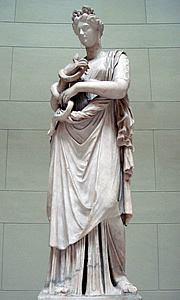
The sanctuary was in operation for at least 600 years from the time of its founding in the late 4th century BC, and members of the family of Asklepios, such as his daughter Hygieia, goddess of health and cleanliness, as well as companions, were also worshipped here.
The sanctuaries all lie outside the Hellenistic walled city of Dion. A substantial settlement existed here at least as early as the 5th century BC to be close to the revered sanctuary of Olympian Zeus. The extensive city remains are primarily of the Hellenistic period.
The city wall shows signs of at least three building periods: the original wall from the time of the Macedonian King Kassander, around 300BC, repairs to the wall after the Aetolian invasion in 219 BC, and late Roman repairs in the mid 3rd century AD and again towards the end of the 4th century. Defensive towers, 7m x 7m square, were built into the wall every 33m. There was also a moat and possibly a harbour on the River Vaphyras on the eastern side.
The rectangular defensive wall enclosed an area of about 43 hectares but the area of the city gradually declined over time. By the mid 3rd century AD it was down to 37 hectares and at the time of the final Roman repairs to the wall in the late 4th century a cross wall reduced the city area further to only 16 hectares.
In its heyday, during Hellenistic and early Roman times, the city was a thriving, bustling metropolis having fine villas, guesthouses and inns, baths and public latrines, temples, churches and a Hellenistic agora succeeded by a Roman forum.
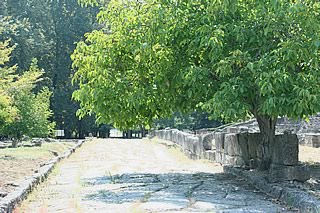
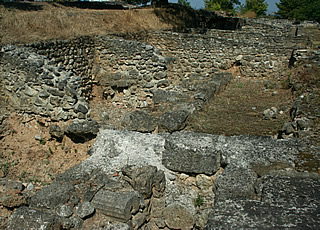
The main road into the city, the Cardo Maximus, is broad and straight traversing the width of the city and its rectilinear grid of streets.
Just inside the south entrance on the west side of the road are a set of well-preserved public latrines with the usual underground water-running cleansing system, which give a very good idea of how they would have originally looked.
There were shops lining the street as well as villas and public buildings such as baths. Each shop would have had a shutter to close it from the street. When open the customer would usually stand on the street side of the counter while the shopkeeper served from behind, and the range of goods would have been extensive: oil,perfume, fish, shoes, fruit and a wide range of other foodstuffs.
A late 4th c. BC "Monument of the Shields" has been set up under cover on the west side. It is thought that this beautiful frieze of military tunics and shields would have originally decorated a Hellenistic building in the agora, though later it was used on the eastern facade of the Roman basilica.
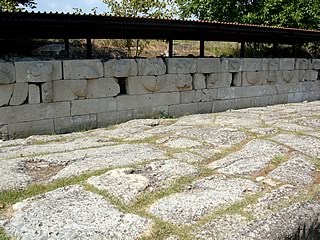
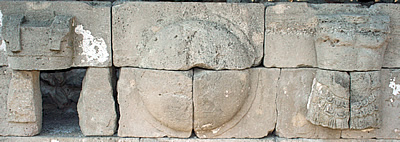
The road is formed from huge blocks of stone, fitted together in a giant mosaic. No doubt it was a bit smoother before the earthquakes but, nevertheless, carts would have had a very bumpy ride, though horses and litters would have been much more comfortable. Like Roman Ostia, or , it is easy to imagine traffic on this road and shops busy with customers.
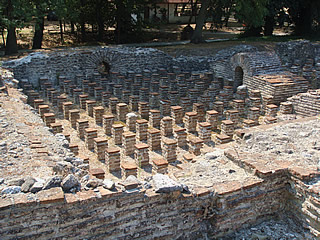
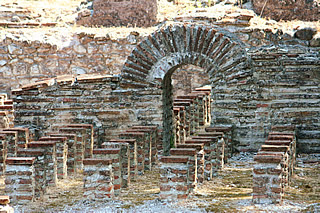
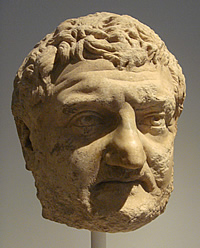
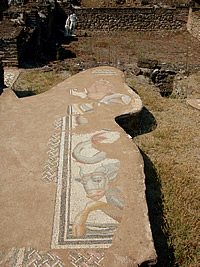
To the west of the public latrines was a large Roman baths complex built in the late 2nd c. AD.
Apart from the usual changing rooms and bathing pools and more latrines, it also encompassed an odeum (a small theatre), rooms for social activities and an area dedicated to the cult of Asklepios.
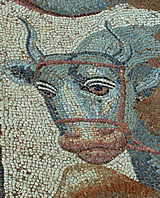
The hypocaust heating system has been exposed and restored and is in very good condition.

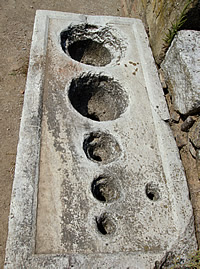
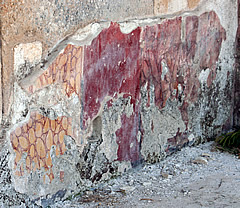
The Roman forum is just to the west of the Monument of the Shields, north of the great baths. This was the administrative centre of the city with public buildings set around a large open square. On the west a small building was discovered with walls painted to look like marble which has been identified as an Augustineum - used in the cult of the Emperor. Two large buildings have also been identified on the west side of the forum, the names of their owners were stamped on the underground lead water pipes. Epigenes' villa also had sewage system. On the west side was the Roman basilica, intended for banking and commercial activities, and also probably the curia where the rulers of the Roman colony held their meetings.
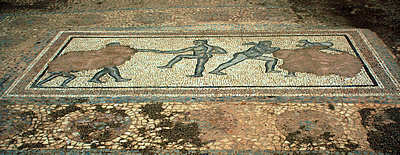
Further along the corso maximus, at the junction with the road leading to the west gate, is a large polygonal building covering about 1400 square metres, probably for us as a market hall. Outside the main entrance on the south side is a large stone block with different sized hollows - some kind of volumetric measuring device. Inside the entrance is a mosaic of wrestlers, quite open to the elements.
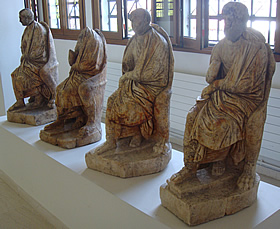
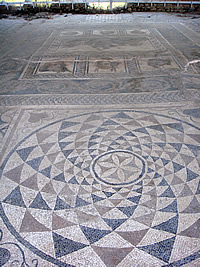
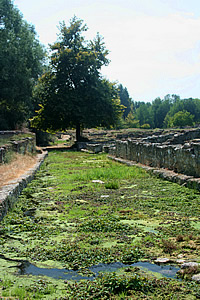
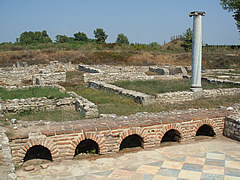
The area of the Dionysus Villa encompasses not only a luxurious villa but also an extensive baths complex and shops as well as the Dionysus shrine. It dates from around the 2nd century AD, at the height of the Roman occupation.


The mosaic floor of a banquet chamber has been particularly well-preserved and is almost intact, showing Dionysus in a panther-drawn chariot and six portraits of actors.
Here at the eastern edge of the city, near the river, the ground is increasingly waterlogged and we hopped from boulder to dry ground making our way south, past the collapsed ruins of the eastern latrines, the House of Zosas where some lovely mosaics were found, and so to a very welcome cold beer before visiting the museum.
